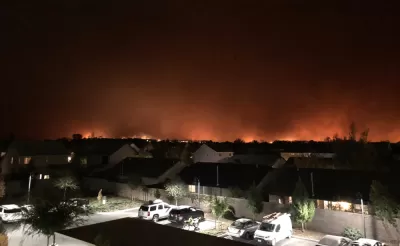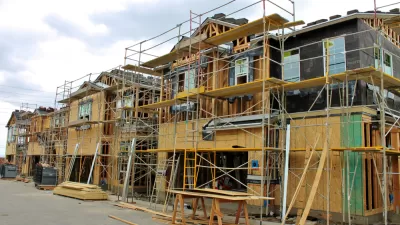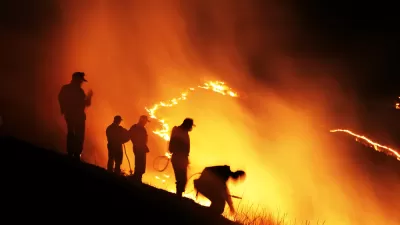New research points to global warming as the biggest factor in fueling longer, more destructive wildfire seasons.

According to new research published in the Proceedings of the National Academy of Sciences, climate change is now the primary driving factor for intensifying wildfire conditions in the western United States, reports Alex Wigglesworth.
The study found that "global warming was essentially two-thirds to 88% responsible for the atmospheric conditions fueling increasingly destructive wildfires," based on an analysis of the vapor pressure deficit. This tracks with other studies showing that 'fire weather days' are happening more frequently, creating longer, sometimes year-round fire seasons.
Fire agencies have had to pivot to new ways of fighting and preventing fires in this changed environment. They include everything from adopting new technologies such as drones and night-flying helicopters to redoubling efforts to focus on fuels management and community outreach and education.
California and the West have faced catastrophic wildfires in recent years, such as 2018's Camp Fire, which ravaged the town of Paradise, killing 85 people and burning roughly 153,000 acres. As fires grow more frequent and destructive, officials struggle to provide fire suppression resources stretched thin across multiple states and support homeowners. Last month, California's Insurance Commissioner announced that the state would bar insurance companies from dropping homeowners in fire-prone areas as an admittedly short-term fix to a growing crisis.
FULL STORY: Climate change is now the main driver of increasing wildfire weather, study finds

Planetizen Federal Action Tracker
A weekly monitor of how Trump’s orders and actions are impacting planners and planning in America.

Maui's Vacation Rental Debate Turns Ugly
Verbal attacks, misinformation campaigns and fistfights plague a high-stakes debate to convert thousands of vacation rentals into long-term housing.

San Francisco Suspends Traffic Calming Amidst Record Deaths
Citing “a challenging fiscal landscape,” the city will cease the program on the heels of 42 traffic deaths, including 24 pedestrians.

Amtrak Rolls Out New Orleans to Alabama “Mardi Gras” Train
The new service will operate morning and evening departures between Mobile and New Orleans.

The Subversive Car-Free Guide to Trump's Great American Road Trip
Car-free ways to access Chicagoland’s best tourist attractions.

San Antonio and Austin are Fusing Into one Massive Megaregion
The region spanning the two central Texas cities is growing fast, posing challenges for local infrastructure and water supplies.
Urban Design for Planners 1: Software Tools
This six-course series explores essential urban design concepts using open source software and equips planners with the tools they need to participate fully in the urban design process.
Planning for Universal Design
Learn the tools for implementing Universal Design in planning regulations.
Heyer Gruel & Associates PA
JM Goldson LLC
Custer County Colorado
City of Camden Redevelopment Agency
City of Astoria
Transportation Research & Education Center (TREC) at Portland State University
Jefferson Parish Government
Camden Redevelopment Agency
City of Claremont





























